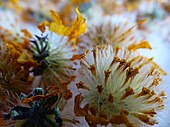Fassmannsreuth
|
Fassmannsreuth
City of Rehau
Coordinates: 50 ° 16 ′ 19 ″ N , 12 ° 7 ′ 27 ″ E
|
|
|---|---|
| Height : | 626 m above sea level NN |
| Residents : | 350 (2018) |
| Incorporation : | May 1, 1978 |
| Postal code : | 95111 |
| Area code : | 09294 |
|
Friedenskirche Faßmannsreuth
|
|
Faßmannsreuth is a district of the town of Rehau in the district of Hof and is about seven kilometers east of the main town.
geography
Faßmannsreuth is located in the east of the city and is surrounded by forest. The place borders the Czech Republic in the east and south . During the Cold War , the Iron Curtain ran right along the corridor border. To the north lies the neighboring village of Sigmundsgrün, to the east, Pastviny . Faßmannsreuth is connected to Regnitzlosau as well as Rehau and the A 93 via the district road HO 4 .
history
The place was first mentioned in a document in 1416. At that time he belonged to the von Feilitzsch family . Other owners in the village were the von Reitzenstein and the Rabensteiner zu Döhlau . In the documents from 1466 to 1544 the place is named as a desert, in 1558 a newly built courtyard was built. Together with the area of the former principality of Bayreuth , Fassmannsreuth came to the Kingdom of Bavaria in 1810 . On May 1, 1978, the previously independent municipality was incorporated into Rehau as part of the Bavarian municipal reform. Were among the districts Faßmannsreuth Dobeneck , Ludwig Brunn , Sigmund Green and Timpermühle .
Culture and sights
When the Napoleonic army withdrew after the Battle of Leipzig , two unknown French soldiers were buried in the woods around Faßmannsreuth in 1813. The twinning between Rehau and Bourgoin-Jallieu emerged from the care of the two French graves over the centuries . The graves have been cared for by the Franco-German Society Rehau (DFG) for decades.
In 1963 the Friedenskirche , built according to plans by the architect Horst Rudorff, was consecrated. It is the first church in the village, before that the residents attended the service in Regnitzlosau .
The only monument in the village is a massive fountain trough made of local granite with the inscription 1755. It has many similarities with the fountain trough at the village pond of Fohrenreuth : a stepped ledge, carved ornaments and two fields with Bible verses on each long side.
Naturhof Faßmannsreuther Erde
The Naturhof Faßmannsreuther Erde is an institution that serves environmental education and aims to help visitors to relax and slow down with a holistic approach . The farm supports the project to revitalize and use arnica as a medicinal plant.
The individual houses and courtyards of the place are built at greater intervals. The Naturhof is embedded in forest and meadow and has an area of 20,000 m². In the show garden there are numerous local shrubs and herbs, as well as a meadow orchard and a wild fruit hedge . This forms the habitat for insects, birds and small wild animals. The Naturhof is operated by the Förderverein Faßmannsreuther Erde eV, which also takes care of the processing of the herbs. In addition to guided tours on the outdoor areas and wild herb hikes, the Naturhof offers training courses and lectures on environmental education and meditation courses. The Naturhof has already won several local environmental prizes, including the 2007 environmental prize for village ecology from the regional association for fruit and horticulture in Upper Franconia.
The area for the revitalization and use of arnica as a medicinal plant begins near the Höllbach , which rises near Faßmannsreuth and forms the border creek to the Czech Republic, immediately behind the Faßmannsreuth soldier's grave . The entire project area extends in the district of Hof with individual areas to Haidberg near Zell in the Fichtelgebirge and into the adjacent district of Wunsiedel . In addition to the maintenance of old stocks, new plants have been sown in recent years and some of the flowers have been processed into a tincture in accordance with nature conservation regulations. The employees of Naturhof Faßmannsreuther Erde support this work on a voluntary basis and make their premises available for the processing steps. The project is part of the National Strategy for Biodiversity . The arnica is one of the 15 plants in the species national responsibility of Germany . The project management lies with the landscape conservation association Hof and the nature conservation office Blachnik.
literature
- Reinhard Höllerich : Former district of Rehau and formerly district-free city of Selb . Historical book of place names of Bavaria , Volume 3, Munich 1977. P. 12f
- Matthias Pfeifer: 600 years of Faßmannsreuth 1416-2016 . Rehau 2016.
Web links
Individual evidence
- ↑ Fichtelgebirge.de: Faßmannsreuth near Rehau , May 5, 2009
- ^ Federal Statistical Office (ed.): Historical municipality directory for the Federal Republic of Germany. Name, border and key number changes in municipalities, counties and administrative districts from May 27, 1970 to December 31, 1982 . W. Kohlhammer GmbH, Stuttgart and Mainz 1983, ISBN 3-17-003263-1 , p. 688 .
- ^ Website of the Naturhof
- ^ Website of the arnica project
- ↑ Flyer for the project ( PDF )
- ↑ Press archive on the homepage of the LAG Landkreis Hof eV





